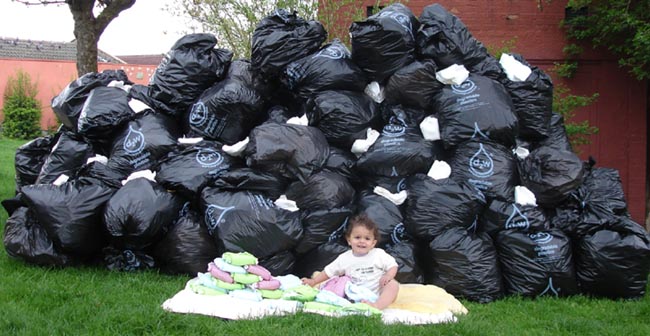
This is taken from a 2018 study by Totsbots and the Nappy Lady
It is easy to focus on the waste issue of single use plastic, but over consumption of finite resources is perhaps the bigger issue, with waste being just the by- product of this overconsumption. Consumers are now starting to switch to more sustainable products but there are many who are still looking for excuses not to switch, for example – ‘what about the energy used in washing’?
The Environment Agency conducted a lifecycle analysis to compare the environmental impacts of reusable and disposable nappies. The report concluded that reusables cloth nappies are up to 40% better for the environment than their disposable counterparts. And to be absolutely clear on this, the study only assessed disposables up to the point of purchase. It did not assess the post use processing of the product ie refuse collection and transport (more carbon in the form of fuel) and ultimately disposal into landfill or incineration (yet more impact in terms of greenhouse gasses such as methane). Reusable nappies on the other hand were assessed both for the manufacturing impacts and the post purchase consumer use from birth to potty training – of course including washing the garments.
So here are some facts and figures:
Materials usage is significantly higher per child:
• 20 x one piece reusable nappies = 2.7KG
• 4,000 x disposables = 150KG
Over 98% less raw materials used per child:
• Disposable = Polyethylene, Polypropylene, Polyacrylate, Cellulose fluff
• Reusable = Polyester, Polyurethane, Cellulose fabric – cotton, bamboo etc.
When looking specifically at the plastic content:
• 25% of a disposable nappy is plastic with a further 4% being adhesive. This equated to 9.57g of plastic per nappy and ultimately 38.2Kg of plastic for disposal – based on 4000 nappy changes per baby.
• A reusable cloth nappy, for example an ‘all in one cloth nappy’ like the Bungenius Freetime, is 50% plastic (Polyester and Nylon).
This therefore equates to 67g per nappy and ultimately 1.34Kg of plastic for disposal at end of life – based on 20 nappies birth to potty. Further reductions in plastic waste can be achieved if parents opt for a 2 part system: with the A bamboo (2 piece fitted nappy) is 19% plastic when you look at a complete set. This equates to 600g of plastic for disposal at end of life – based on 20 nappies and 4 covers.
Most high quality reusable nappies, when cared for properly can be used for a second child further reducing impact (2 children in disposables will result in 76.4Kg of plastic for disposal).
Many parents are opting to use ‘eco’ disposable nappies as a more environmentally friendly alternative to the mainstream brands. However, these products have the same impact in production and use the same amount of raw materials per child as the standard product. Claims of biodegradability are spurious at best as the majority of the product still ends up in the regular domestic waste stream. In short it is a greenwash. If parents want to reduce their environmental impact, then reusable cloth nappies are the only alternative.
.
